
Should I Buy A used car Seat?
Buying second hand baby goods is a great way to save money. But if there’s one thing worth forking out for, it’s a car seat. A car seat is a life saving device that is designed to protect children in the event of a car crash.
If finances allow, try to buy a new car seat rather than second hand. This is because you cannot be completely certain of a car seat’s history unless you buy from someone you know and trust. A car seat that has been compromised may not show obvious damage, but it may not protect your baby sufficiently if it were to be involved in a crash.
All car seat manuals state that it is not recommended to use a car seat secondhand or whose history you do not know, because they may have structural damage that endangers your child's safety.
Car seats are very expensive, and we fully appreciate that many families simply cannot afford a new car seat.
If you do need to buy second hand, it is preferable to buy from the owner rather than a second hand baby shop or charity store, so that you can obtain the car seat's history and inspect it thoroughly. In this article, we discuss the key points to inspect before considering buying a secondhand car seat:

1. Has it been in any crashes or dropped?
A car seat that has been involved in car crash, whether occupied or not, should be replaced and not used again. Although it may look fine, there may be unseen damage that may compromise its safety and prevent it from performing optimally if it were involved in a second crash. Some car seat manuals state that a car seat involved in a collision as slow as 10km per hour should be replaced.

The NHTSA advises “Crash damage is not always visible to the naked eye. There are some scans and X-rays that can find hidden damage, but the cost of these tests is usually greater than the cost of the most expensive new car seat. Without this type of test, no one can inspect your car seat and certify it as safe after a crash”
These tests are NOT available in South Africa, and without them, no-one can verify if a seat is safe to continue using after a crash.
FaceBook pic

When to replace a Car Seat
Below are the general guidelines on when to replace a car seat. However, if your manual states differently, the manual overrides these guidelines:
- Check 1: The car was towed away
- Check 2: The vehicle door closest to the car seat was damaged
- Check 3: A person in the car was injured in any way
- Check 4: Any airbag in the car was deployed
- Check 5: There is visible damage to the car seat (cracks, stress marks etc)
- Check 6: The car seat manual states that you must replace your seat after any accident

2. When was the seat manufactured?
Our European car seats do not have expiry dates as such, like American car seats do, however, each manufacturer will have a recommended lifespan for each model. This ranges between 4 to 12 years, depending on the specific model. It is important to check your manual for your specific model, as each model has a different maximum recommended lifespan. Many manufacturers recommend that a child car seat be replaced after 5 years, because child car seats are constantly being improved and upgraded.
Our car seats are tested to the previous ECE regulation 44 (R44/04) or the new car seat regulation R129 (iSize). Car seats tested to R44.01 or R44.02 are now very old and illegal to sell and use. We still see these old and expired car seats for sale online and in charity stores, so please beware! Car seats that have been tested to R44.03 are likely to be quite old as R44.03 was introduced in 1995, so they may be up to 20 years old.
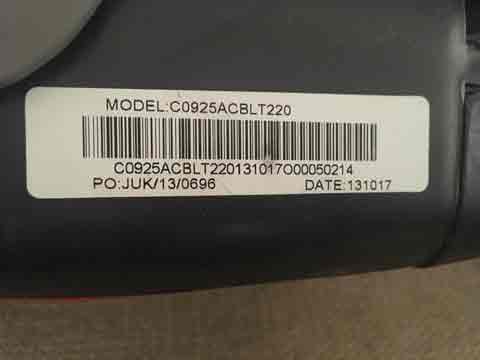
Manufactured on 13/08/2010

Manufactured in the 31st week of 2013
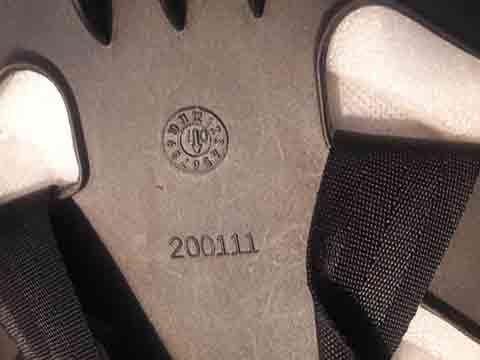
Manufactured in the 6th month of 2007
It is recommended that child car seats should not be used for longer than the manufacturer's recommended lifespan, as that is how long they have tested the seat and guarantee its use for. This is because the materials of a car seat will begin to degrade from wear and tear and weather conditions over time. An old car seat may not perform as it should do in a collision.
3. Are all parts intact?
Remove the cover and inspect that all parts of the harness, buckle, covers, buckle padding, lock off clips and EPS Styrofoam are present. A cracked EPS will need to be replaced, and not all South African suppliers bring these spare parts in or are able to service them.
4. Is THE manual available?
It is essential that you follow the manual in order to install it correctly. Many manuals can be found online or you can request it directly from the manufacturer or distributor.
5. Are there any signs of white stress marks, damage, rusting or fraying?
Stress marks, cracked EPS, fraying or rusting may indicate that the seat is old and/or has not been well cared for or stored properly.
White stress marks on the shell of the car seat or broken (EPS) Styrofoam indicate that it may have been dropped or in a crash.
If you suspect it has been damaged, do not use it!
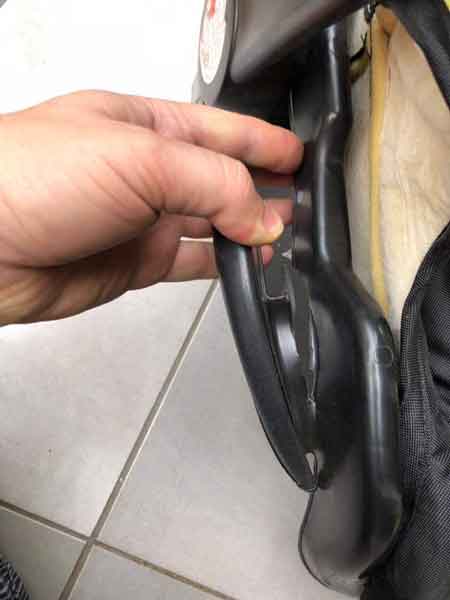
Cracked Car Seat Frame
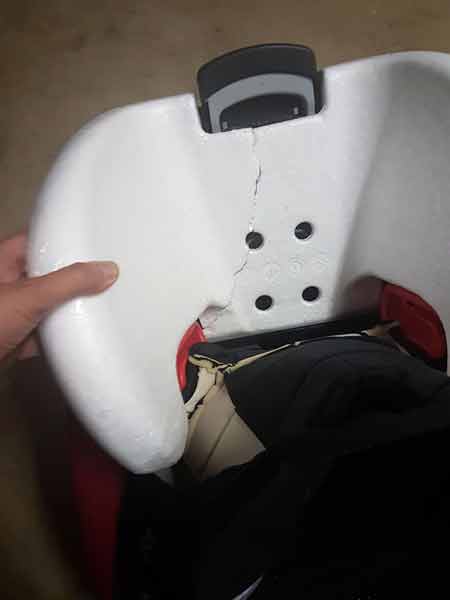
Cracked EPS
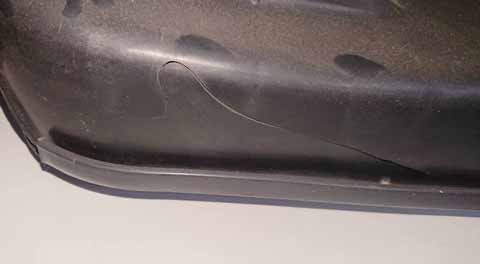
Cracked Base
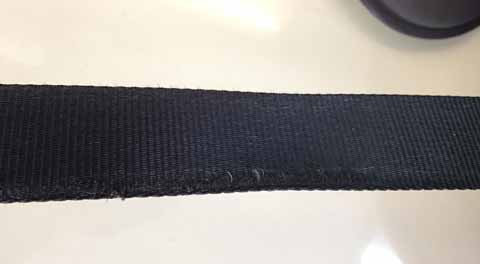
Frayed Harness
6. Has it been checked for any recalls?
Photo Credit: Extreme Couponing
You can check a car seat's recall history on Which.co.uk and Europa. If you have a rebranded car seat i.e the brand is only available in South Africa, please check the car seat and manual for the manufacturer's name and search the recall history under the manufacturer's name not under the South African brand name.
Please bear in mind that the model name may not be found anywhere on the seat, and many car seats have similar model names. Some infant-only seats are sold as a part of a stroller system. Since stroller model names are not included on this list, it is necessary to determine the name of the infant car seat to check if any recalls or warnings have been issued.
Some manufacturers have style names (i.e., Nania, Ferrari, Disney characters, etc.) sewn on the fabric or used in promotional materials. These names are used for more than one product and cannot be used to determine whether or not the seat has a recall. If you are not sure of the exact name of your seat, check the manual or contact the manufacturer to help you identify it.
7. Has it been independently crash tested?
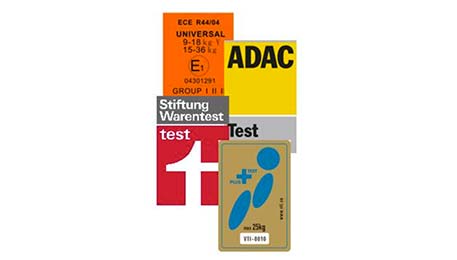
Some car seats that are sold in Europe are selected for additional, independent crash testing at higher speeds. The results are published by ADAC in German and by Which (for a membership fee) for the public to access.
All available safety reviews are translated into English and uploaded into photo albums on Car Seat Support South Africa. It would be preferable to buy a car seat with good ADAC safety ratings. For more information on crash testing, read our article here.
8. Has it been checked on an airplane?
It is a common complaint that parents, who have checked their car seats in as fragile luggage, have received them back with broken polystyrene and torn covers. A sure sign that they were dropped.
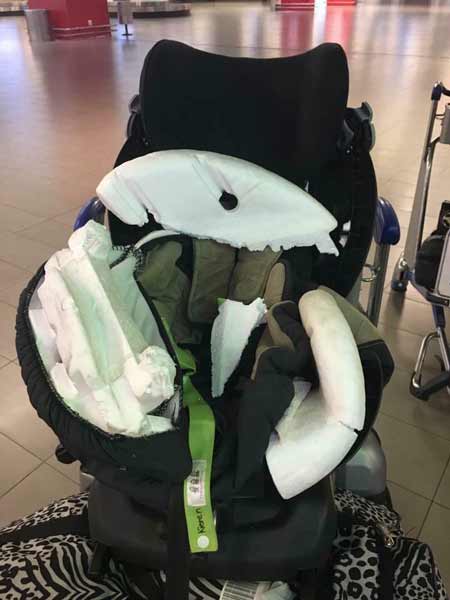
If a car seat is checked in, it should be well padded with polystyrene, towels and/or bubble wrap AND boxed. Bubble wrap alone will protect the upholstery but will not protect the shell if dropped. Check the car seat for signs of damage or stress. If it has been loaded on a plane and wasn't suitably protected, it may not be safe to use.
9. Has it been washed and dried only according to the instructions in the manual?
Car seat manufacturers specify exactly what is and is not allowed when cleaning a car seat. Not adhering to the manual instructions could weaken the harness. Ask if the harness ever been treated with harsh soaps (like a strong detergent, bleach or vinegar?) or put through the washing machine.
Car seats should never be dry cleaned, steam cleaned or hosed down.
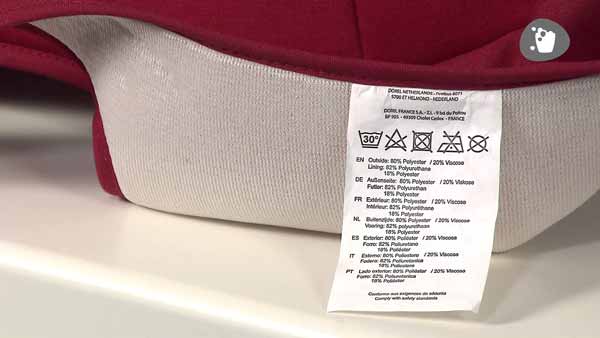
Car Seats For the Littles recommends that if a used car seat from a trusted friend is not expired, not damaged, not recalled, has been well cared for, and you trust the original owner, it may be fine to consider using a used car seat for your child.
However, if the answer to any of those questions is uncertain, we’d suggest purchasing a brand new seat from an approved retailer.

